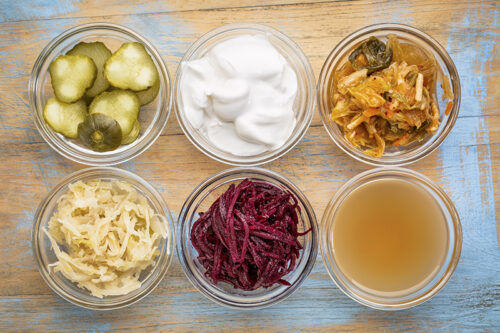For years, scientists have been aware of the adverse effects of antibiotics. When they are necessary, however, you can mitigate these side effects with the use of prebiotics and probiotics. These help protect the bacteria that live in our gut biomes and provide a range of necessary benefits.
What are prebiotics and where are they found?
Prebiotics are a subset of dietary fibers that help the gut biome grow better. They are found in a wide range of fibrous foods, including onions, bananas, chicory root, flaxseed, seaweed, garlic, and whole grains.
The greatest sources of prebiotics currently known are two root vegetables: yacon, similar to jicama, and the Jerusalem artichoke, more commonly called sunchoke.
What are probiotics?
Probiotics are slightly different from prebiotics in that they need to travel to the colon undigested. Once there, the probiotic ferments and feeds the gut flora, providing many physiological benefits. Probiotics can be taken as dietary supplements, or are available over the counter as tablets or capsules.
Some excellent probiotic supplements are:
- Culturelle
- Nature Made Acidophilus
- Align (Bifantis)
- Florajen
What foods have probiotics?[/vc_column_text][vc_raw_html]JTNDaWZyYW1lJTIwd2lkdGglM0QlMjI1NjAlMjIlMjBoZWlnaHQlM0QlMjIzMTUlMjIlMjBzcmMlM0QlMjJodHRwcyUzQSUyRiUyRnd3dy55b3V0dWJlLmNvbSUyRmVtYmVkJTJGb2l2eU8zclJ4U00lMjIlMjB0aXRsZSUzRCUyMllvdVR1YmUlMjB2aWRlbyUyMHBsYXllciUyMiUyMGZyYW1lYm9yZGVyJTNEJTIyMCUyMiUyMGFsbG93JTNEJTIyYWNjZWxlcm9tZXRlciUzQiUyMGF1dG9wbGF5JTNCJTIwY2xpcGJvYXJkLXdyaXRlJTNCJTIwZW5jcnlwdGVkLW1lZGlhJTNCJTIwZ3lyb3Njb3BlJTNCJTIwcGljdHVyZS1pbi1waWN0dXJlJTNCJTIwd2ViLXNoYXJlJTIyJTIwYWxsb3dmdWxsc2NyZWVuJTNFJTNDJTJGaWZyYW1lJTNF[/vc_raw_html][vc_column_text]Probiotics are also found in a variety of foods, like active culture yogurts and fermented foods. Examples of fermented foods include sauerkraut, miso, kimchi, sourdough bread, tempeh, and pickles, all of which naturally contain probiotics.
There are also fermented drinks like Kefir, which is a fermented milk drink, and Kombucha, which is a fermented tea with bacteria and yeast.
How have human dietary changes affected our gut health?
Unlike the foods our ancestors consumed just one hundred years ago, modern groceries now contain much fewer bacteria. While it is a good thing to avoid harmful bacteria like salmonella or E. coli, foods also used to contain healthy bacteria.
One might even argue that our food today is too clean and too healthy for our own good. With such an emphasis on food cleanliness, we are no longer exposed to the healthy bacteria that live in the soil and on crops. This is a problem because our gut microbiomes need these bacteria to function properly.
Why is our gut microbiome so important?
The average person carries about 2 kg or 4.4 lbs of microbes in the gut. This is around the same weight as the human brain! This gut flora is immensely important in many ways. It helps influence the development and function of our nervous and immune systems, protecting against pathogenic adhesion to the intestine and suppressing proinflammatory cytokines which have been linked to colon cancer.
It contributes to energy levels and metabolism through the fermentation of short-chain fatty acids. The gut microbiome is also responsible for producing vitamins like B6 and B12 and enhancing the absorption of calcium, iron, and magnesium.
Why are prebiotics and probiotics becoming more common?
It can be hard to keep the gut microbiome healthy, especially if a patient needs antibiotics or is on chemotherapy. Healthy gut bacteria can be caught in the crossfire of these treatments. In such cases, it is essential that patients consider supplementing their diets with prebiotics and probiotics.
When should probiotics be used?
One of the biggest uses of probiotics is in conjunction with antibiotics. Antibiotics can lead to two main problems for patients’ gut health, and have been estimated to do so in up to 36% of people who take antibiotics. T
hese are the disruption of normal gut flora, known as antibiotic-associated diarrhea (ADD). The second is an overgrowth of the pathogen Clostridium difficile (C. diff) which causes C. difficile-associated diarrhea (CDAD).
Antibiotics that have a higher risk for CDAD include:
- Clindamycin
- Fluoroquinolones
- Cephalosporins
- Penicillins (amoxicillin)
Antibiotics with a moderate risk include:
- Imipenem
- Macrolides (azithromycin, clarithromycin, erythromycin)
- Sulfa-trimethoprim (Bactrim)
Antibiotics with a lower risk include:
- Aminoglycosides
- Metronidazole
- Nitrofurantoin
Data suggests the most effective use is to get probiotics onboard when a patient starts antibiotics. Because adverse effects of probiotics are very rare, it is best to not wait until the patient presents with diarrhea symptoms.
What is the evidence for the use of these products?
Probiotics have been shown to restore altered gut flora and help with diarrhea, ulcerative colitis, irritable bowel syndrome, and more. In patients taking antibiotics, probiotic usage reduced ADD in up to 42% of cases.
How should patients take probiotics?
Probiotics are most effective when taken on an empty stomach between 1-2 hours after the oral antibiotic or antifungal medication. It is best not to have both in the stomach at the same time, so patients should wait to take the probiotic after they have had time to digest.
One very important note for taking probiotics is that patients should continue for a minimum of 1-2 weeks after the completion of the antibiotic. This allows the gut flora to recolonize after the antibiotic is no longer causing that reduction.
When should probiotic and prebiotic use be avoided?
Adverse effects of probiotics are very rare. That said, if a patient is using active culture yogurt as their source of probiotics, there are a few things to keep in mind. First, yogurt contains a lot of calcium, which can cause an increased risk of kidney stones. To equal the probiotics available in a supplement, you would need to consume around 1-3 servings of Activia per day. For this reason, dietary supplements can be a safer option for some patients.
Second, yogurt can reduce antibiotic efficacy in certain tetracyclines like doxycycline and fluoroquinolones if they are taken too close together. For these antibiotics, the consumption of yogurt should be more than two hours separate in order to avoid a potential chelation effect.
Are there any other use cases for probiotics?
There are two interesting use cases for probiotics. The first is that probiotics have been shown helpful in women with frequent recurrent yeast infections (Candida vaginitis). Especially in women for whom anti-fungal medications have adverse effects of contraindications, oral probiotics can be a safer way to recolonize the lower gut.
The second is an emerging issue in the medical community. We are learning that the gut biome has a unique role in our experience of pain. It is possible that manipulation of the flora via prebiotics and probiotics could help regulate pain in patients with visceral pain disorders. This is a topic of ongoing research.






